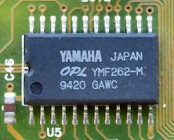First post, by Intel486dx33
I have a CT1740 sound card with a Yamaha YMF262 chip.
I can not get MIDI files to play.
So I want to know if this chip purpose is to be able to play MIDI files and what is the driver for it.
I can play .wave files fine. Just not MIDI.
I have the Sound Blaster drivers installed.
everything appears to be working fine I just can't play MIDI files.
The MIDI program reports that I may not have the MIDI settings correctly.
Should I use FM synthesis or a MIDI Port ?
